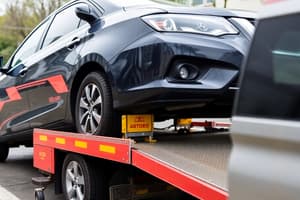Podcast
Questions and Answers
What is the primary goal of vehicle safety?
What is the primary goal of vehicle safety?
- To enhance vehicle aesthetics
- To prevent accidents, minimize injuries, and reduce fatalities (correct)
- To improve fuel efficiency
- To increase vehicle speed
Which of the following is an example of a passive safety feature?
Which of the following is an example of a passive safety feature?
- Lane departure warning
- Airbags (correct)
- Anti-lock braking system (ABS)
- GPS navigation
What is the purpose of crumple zones in vehicle design?
What is the purpose of crumple zones in vehicle design?
- To increase vehicle speed
- To improve fuel efficiency
- To enhance vehicle aesthetics
- To absorb impact energy and reduce damage to the vehicle (correct)
Which organization awards stars (1-5) based on adult occupant protection, child occupant protection, pedestrian protection, and safety assist features?
Which organization awards stars (1-5) based on adult occupant protection, child occupant protection, pedestrian protection, and safety assist features?
What is the purpose of electronic stability control (ESC)?
What is the purpose of electronic stability control (ESC)?
Which of the following is an example of a government regulation related to vehicle safety?
Which of the following is an example of a government regulation related to vehicle safety?
What is the purpose of crash testing?
What is the purpose of crash testing?
Which organization develops standards for vehicle safety?
Which organization develops standards for vehicle safety?
Flashcards are hidden until you start studying
Study Notes
Introduction to Vehicle Safety
- Vehicle safety refers to the safety of vehicles on the road, including their design, construction, and operation.
- The primary goal of vehicle safety is to prevent accidents, minimize injuries, and reduce fatalities.
Safety Features
- Passive Safety Features:
- Airbags: deploy in the event of a crash to cushion the impact and reduce injury.
- Seatbelts: restrain occupants to prevent ejection from the vehicle.
- Crumple zones: designed to absorb impact energy and reduce damage to the vehicle.
- Active Safety Features:
- Anti-lock braking system (ABS): prevents wheel lockup during hard braking, maintaining traction and control.
- Electronic stability control (ESC): helps the vehicle stay stable and on course by controlling engine power and applying brakes to individual wheels.
- Lane departure warning and lane keep assist: alert the driver if the vehicle drifts out of its lane and can even make corrections to steer the vehicle back on course.
Crash Testing and Ratings
- Crash Testing: vehicles are subjected to controlled crashes to assess their safety performance.
- Safety Ratings:
- Euro NCAP (European New Car Assessment Programme): awards stars (1-5) based on adult occupant protection, child occupant protection, pedestrian protection, and safety assist features.
- NHTSA (National Highway Traffic Safety Administration) ratings: award stars (1-5) based on frontal and side crash tests, as well as rollover resistance.
Safety Regulations and Standards
- Government Regulations: governments establish laws and regulations to ensure vehicle safety, such as mandatory safety features and emission standards.
- Industry Standards: organizations like the International Organization for Standardization (ISO) and the Society of Automotive Engineers (SAE) develop standards for vehicle safety.
Emerging Trends in Vehicle Safety
- Advanced Driver-Assistance Systems (ADAS): features like automatic emergency braking, blind spot detection, and adaptive cruise control are becoming increasingly common.
- Autonomous Vehicles: self-driving cars and trucks are being developed, with a focus on eliminating human error and improving safety.
- Vehicle-to-Everything (V2X) Communication: technology that enables vehicles to communicate with other vehicles, pedestrians, and infrastructure to enhance safety and efficiency.
Vehicle Safety Overview
- Vehicle safety encompasses design, construction, and operation to prevent accidents, minimize injuries, and reduce fatalities.
Safety Features Classification
- Passive Safety Features: • Airbags deploy in crashes to cushion impact and reduce injury. • Seatbelts restrain occupants to prevent ejection from the vehicle. • Crumple zones absorb impact energy and reduce vehicle damage.
- Active Safety Features: • Anti-lock braking system (ABS) prevents wheel lockup during hard braking. • Electronic stability control (ESC) helps vehicles stay stable by controlling engine power and applying brakes. • Lane departure warning and lane keep assist alert drivers and make corrections to steer the vehicle back on course.
Crash Testing and Safety Ratings
- Vehicles undergo controlled crashes to assess safety performance in crash testing.
- Safety Ratings: • Euro NCAP awards 1-5 stars based on adult occupant protection, child occupant protection, pedestrian protection, and safety assist features. • NHTSA ratings award 1-5 stars based on frontal and side crash tests, as well as rollover resistance.
Safety Regulations and Standards
- Government Regulations: governments establish laws and regulations to ensure vehicle safety, including mandatory safety features and emission standards.
- Industry Standards: organizations like ISO and SAE develop standards for vehicle safety.
Emerging Trends in Vehicle Safety
- Advanced Driver-Assistance Systems (ADAS): features like automatic emergency braking, blind spot detection, and adaptive cruise control are becoming increasingly common.
- Autonomous Vehicles: self-driving cars and trucks focus on eliminating human error and improving safety.
- Vehicle-to-Everything (V2X) Communication: technology enables vehicles to communicate with others, pedestrians, and infrastructure to enhance safety and efficiency.
Studying That Suits You
Use AI to generate personalized quizzes and flashcards to suit your learning preferences.




